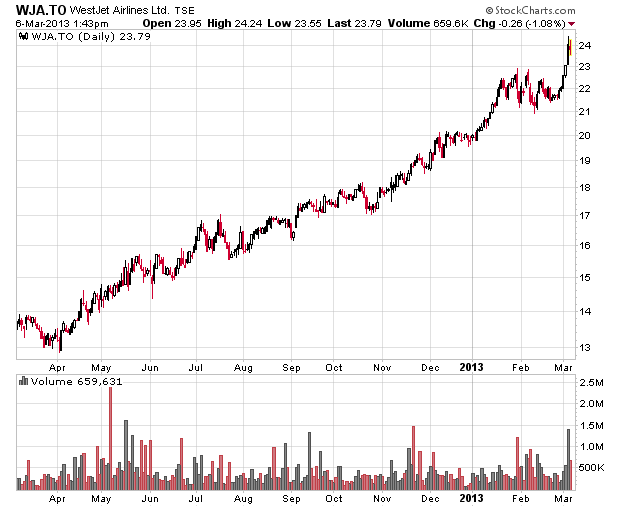The words from Warren Buffett resonate within my mind when I recall him saying that the cumulative retained earnings out of the airline sector is negative.
This brings us to Westjet’s (WJA.TO) and Air Canada’s (AC.B.TO)’s relative good performance over the past year – shareholders are up 150% and life is good:
I won’t examine Air Canada because there are a whole bunch of other messy variables to take into consideration (pension liabilities, special government regulatory business, the fact that it is Air Canada, etc.) but we will take a very superficial look at Westjet.
Looking at their year-end results, the corporation has an existing market capitalization of $3 billion, $1.46 billion in cash, $739 million in debt (thus enterprise value of about $2.3 billion) and delivering about $452 million in free cash flow to its investors – a multiple of about 5 times free cash flow. What is not to like about this?
The profits were generated through high seat loading factors (Westjet did 82.8% of seats filled in 2012) and fare rates being sufficiently high, in addition to fuel costs being moderate through the year.
In other words, everything is going quite well for Westjet and they had a banner year. It looks like this is continuing in 2013 – in February they announced a load factor of 86.1%.
An investor will ask – what is the upside from here? The only upside I see is through sheer trading momentum – this is why I would not want to short the stock at present. The higher the stock price goes, the more tempting the short case may seem under the inevitable basis that eventually competition will eventually catch up to the airline and there will once be some overcapacity in the industry. Until then, there is no reason for the stock to not go higher – they could reach $30 or even $40 a share and you could make a “numbers” case for the company’s valuation just based off of free cash flow. The lack of solvency risk (i.e. cash higher than debt at present) is also another bullish case.
Interestingly enough, Air Transat (TRZ.B.TO) has not exhibited the same trajectory, so some inferences can be made on the vacation destination market vs. regular North American travel.

